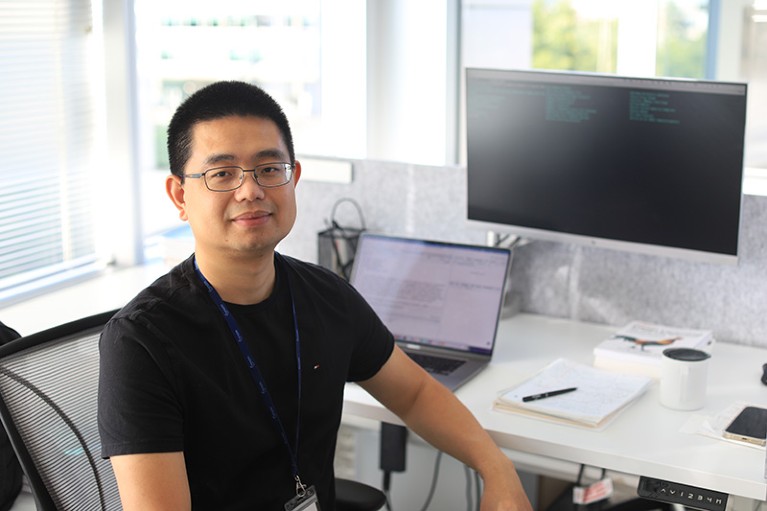
Ming Tommy Tang needs to help other researchers make the leap to computational biology.Credit history: Jiaming Yu
Sitting down at my business office desk driving a substantial display screen and a Macbook, I am crunching solitary-mobile gene-expression data. But there’s no arrow pointer to be viewed, mainly because I’m not applying my mouse. I am analysing these knowledge applying prepared recommendations issued in the languages of computational biology: Bash, R and Python.
With additional than 10 several years of encounter analysing DNA and RNA sequencing details, I lead the computational biology staff at Immunitas Therapeutics in Waltham, Massachusetts. I share computational ideas and tips in web site posts and on X (formerly Twitter), on which I have a lot more than 25,000 followers.
Fifteen many years ago, I was a PhD pupil in a cancer molecular biology laboratory at the College of Florida in Gainesville, and all the things was new. I was enthusiastic to find out. I clocked at minimum 10 hours in the lab each working day, and promptly became a pipetting qualified. I printed my 1st initially-creator paper in 2011 and the next in 2013. I was emotion superior about my development.
Then, a person working day, my adviser asked me to analyse a info set from the Gene Expression Omnibus, a general public repository managed by the US National Middle for Biotechnology Facts. The knowledge were gathered utilizing chromatin immunoprecipitation adopted by superior-throughput DNA sequencing (ChIP-seq), a genome-scale procedure for mapping the binding websites of DNA-binding proteins referred to as transcription components, as properly as locations enriched in modifications of histone proteins. My graduate adviser wished me to probe one particular of these data sets to learn wherever a transcription element named hypoxia-inducible aspect-1 binds to the human genome.
The file was 2 gigabytes. I downloaded it, but with extra than five million rows of data it crushed Excel, and I did not know what else to do. I recognized for the initial time that on the other hand good my palms were in the lab, I lacked the info-investigation abilities that are increasingly necessary to present day lifestyle science.

The command line is necessary understanding for computational biologists.Credit rating: Getty
My introduction to people capabilities arrived unexpectedly. A colleague in the bioinformatics division at the College of Florida experienced made a instrument to forecast substitute messenger RNA ‘splice’ web pages in genes, and a member of his thesis committee requested him to validate his predictions experimentally. I made available to assistance. I developed 20 sets of the DNA primers that flank the predicted junctions where by the splicing takes place, amplified the sequences concerning them, and separated them on a gel. In most scenarios, the primers amplified the wanted sequences, showing that his predictions were being proper. He handed his defence.
As a token of appreciation, my friend’s graduate adviser asked how he could help me in return. I claimed I needed to understand bioinformatics, so he gave me a crash course, demonstrating textual commands to form terms, determine exceptional values and manipulate tabular data, amongst other factors. It was not significantly, but it was the initial time I had seen another person interacting with the computer system in this way, and I was hooked. I decided on a transform of strategy: I would turn out to be a computational biologist.
Brave new planet
To newcomers, the textual content-dependent command line — identified as the terminal — can appear terrifying and unintuitive relative to the drag-and-fall simplicity of modern graphical user interfaces. But it was crucial that I discover it. For one detail, the analyses that my adviser wanted could not be performed any other way. Most bioinformatics applications are composed to operate at the command line. And when using significant-effectiveness computing clusters or doing work in the cloud you have no decision — these computer systems have no graphical interface. As well as, these terse commands are exceptionally excellent at textual content manipulation, and when it comes to bioinformatics, text documents are the coin of the realm. By chaining straightforward instructions jointly working with the pipe symbol (‘|’), bioinformaticians can wrangle simple text data files into the wanted structure to feed into their workflows.
The command line is baked into Unix-Linux working programs. Consumers of macOS can obtain it through the Terminal software, while consumers of Windows 10 and 11 can set up the Windows Subsystem for Linux. (Buyers of more mature versions of Home windows will have to manually develop a twin-boot system, as I did.)
The command line, I understood, would propel me in the direction of computational biology, but it was a rabbit gap. I commenced to pile up publications on my bookshelf. I expended several hours environment up a twin-boot procedure to load Linux on my Home windows machine. And I started out looking through on the net tutorials and textbooks to understand the essentials.
Two methods proved invaluable. The initial is an on the web class on the Unix shell from The Carpentries, an group in Oakland, California, that delivers workshops on data analysis in science. The 2nd is the on the web e book, The Linux Command Line (2019). Newcomers can also test out my own e book, From Cell Line to Command Line (2022).
Even with those aids, do not be surprised if you run into problems. Linux instructions aspect unintuitive syntax with bewildering and often inconsistent parameters, and it can choose months of follow to become proficient. As a single nameless person quoted in The Artwork of Unix Programming (2003) claimed, “Unix is person-friendly — it’s just picky about who its pals are.” In other terms, Unix isn’t intuitive, until eventually it is it just requires observe.
As my studying progressed, I observed myself at the keyboard more and applying my pipettes fewer. And, the moment I nailed the essentials, I transitioned to the R and Python programming languages and concluded my transformation. I did a postdoc in computational biology at the MD Anderson Most cancers Heart in Houston, Texas, adopted by a non-tenure keep track of placement at the Dana-Farber Most cancers Institute in Boston, Massachusetts, the place I led a computational crew to analyse single-cell and medical demo sequencing info.
10 years soon after starting up my journey to the command line, I guide a computational biology team at a drug-development enterprise. It was not constantly easy I was the only a person on my flooring discovering it back in Florida and experienced no a person to change to for enable. I was blessed to have practical colleagues for the duration of my teaching in Houston who taught me superior abilities, but I required to operate most items out myself.
By means of that expertise, I learnt the value of becoming open-minded and truly curious. I now embrace every single problem with willpower and self-control, confident that I have the equipment and capabilities important to triumph. I am also committed to supporting other wet-lab biologists make the exact transition that I did. If you’d like to make the leap on your own, verify out my web site.

